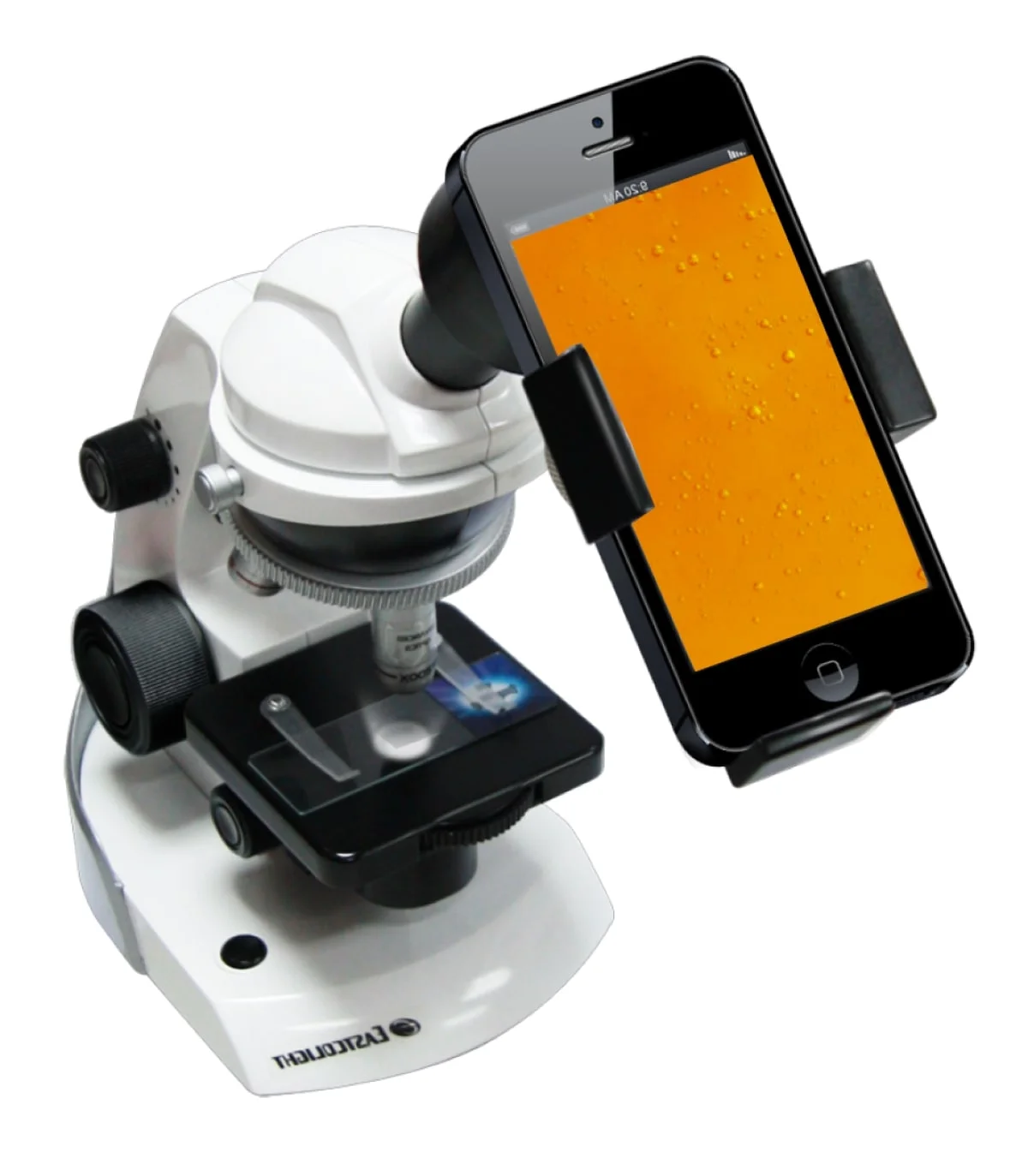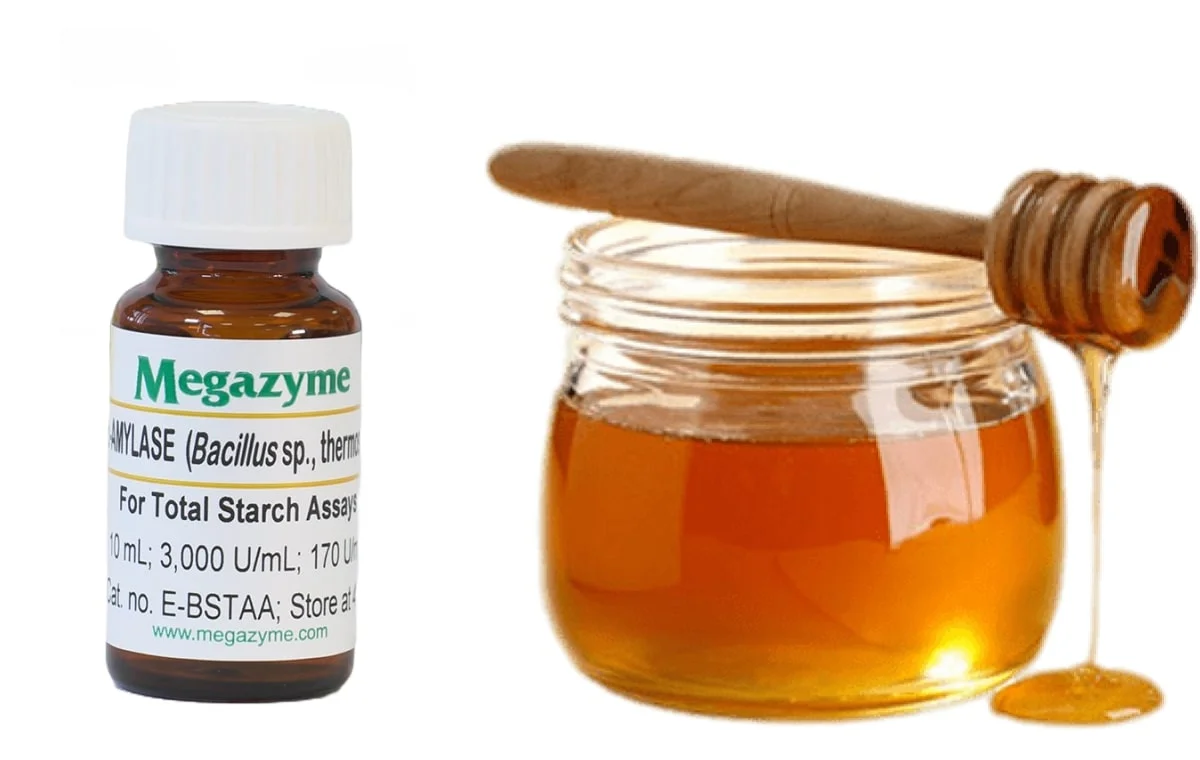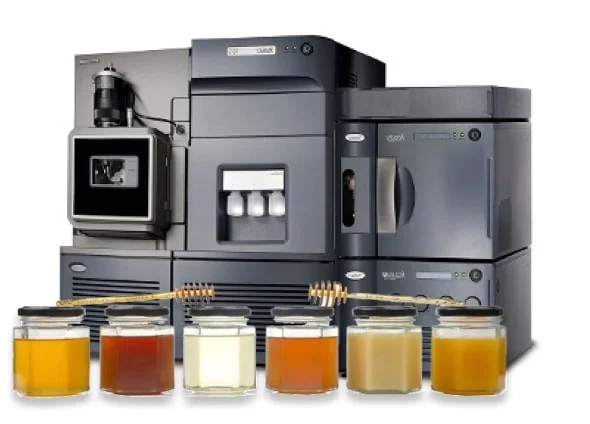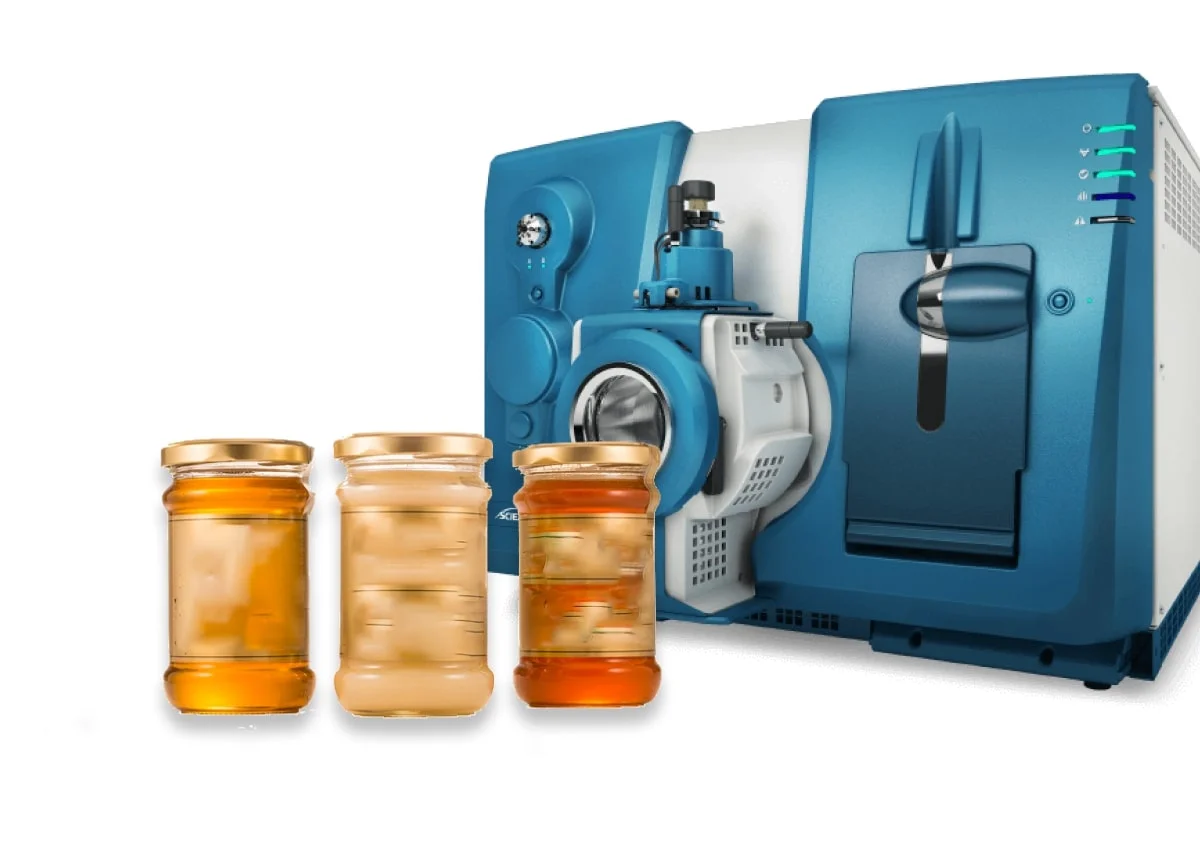honey qulality
Honey is a sweet saviour for all those health enthusiasts that want to have the taste without compromising their health. But, honey won’t serve this purpose, if it’s been adulterated. However, what are these adulterants anyways, well the most common ones are given here
Adulterants in Honey
-
Liquid Glucose
A thick and shiny glucose which is used mostly in baking and confectionery industry is used as an adulterant. They are used because of easy availability and cost-effectiveness.
-
Molasses
It is a viscous and thick sugarcane juice. When sugarcane juice is boiled it gives a dark and turbid solution, which almost tastes like honey.
-
Rice Syrup
During the processing of rice, a syrup is produced called rice syrup. This is one of the most common adulterants of honey over the world.
-
High glucose corn syrup (HFCS)
Whenever the sweetcorn is processed, this corn syrup is produced. The consistency and composition of HFCS is very similar to honey.
-
Invert Sugar
A thick and shiny liquid used as an adulterant for honey, which is produced during the refined sugar’s processing.


Many honey companies claim that it provides the best, adulterant free, colorant free, preservatives free, pure, 100% organic, wild honey. But, how do you trust that it is actually providing the quality it claims? Well, you can trust them from the wide range of essential quality control and assurance tests it performs during the whole process from harvesting the honey from honeycomb to packaging & delivering it at your doorstep.
However, what are these tests, how are they performed, and how does it ensure the quality of honey you buy? Well, you need not have to worry about it because here you will learn about all those tests. So that you can buy the best quality of honey.
Internationally acclaimed tests & their permissible limits
| Sr. No. | Parameters | Limit |
|---|---|---|
| 1. | Moisture percentage by Mass, Max. | 20 |
| 2. | Specific Gravity at 27 degrees Celsius, Min | 20 |
| 3. | Diastase activity, Schade units per gram, Min. | 3 |
| 4. | Hydroxymethylfurfural (HMF) mg/kg, Max. | 80.0 |
| 5. | Fructose to Glucose ratio (F/G) | 0.95-1.50 |
| 6. | Free acidity mill equivalents acid / 1000 g, Max. | 50.0 |
| 7. | Acidity expressed as formic acid, per cent, by mass, Max. | 0.20 |
| 8. | Total Ash, percent by mass, Max. | 0.50 |
| 9. | C4 sugar, percent, by mass | 7.0 |
| 10. | Foreign Oligosaccharides, Max. Percent | 0.7 |
| 11. | Electrical Conductivity | 0.8 mS/cm |
| 12. | Proline, mg/kg, Min | |
| 13. | Pollen count/ g. Min. | 5000 |
| 14. | Total Reducing Sugars | 65% |
| 15. | Sucrose | 5% |
| 16. | Water Insoluble Matters | 0.10% |
| Sr. No. | Parameters | Limit |
|---|---|---|
| 17. | Ethanol Content | 0.02% |
| 18. | Trace Metval Content | |
| a) Cadmium (Cd) | 0.01 mg/kg | |
| b) Copper (Cu) | 0.1 mg/kg | |
| c) Arsenic (As) | 0.01 mg/kg | |
| d) Lead (Pb) | 0.01 mg/kg | |
| e) Iron (Fe) | 1.0 mg/kg | |
| f) Zinc (Zn) | 0.1 mg/kg | |
| 19. | Artificial Sweeteners | |
| Acesulfame K | 10.0 mg/kg | |
| Aspartame | 10.0 mg/kg | |
| Saccharine | 10.0 mg/kg | |
| 20. | Tutin Content | 0.05 mg/kg |
| 21. | Total Aflatoxin Content | 0.4 μg/kg |
| 22. | Pesticide Residue Parameters | 0.01 mg/kg |
Physico-chemical Parameters of Honey Purity Testing
Many honey companies claim that it provides the best, adulterant free, colorant free, preservatives free, pure, 100% organic, wild honey. But, how do you trust that it is actually providing the quality it claims? Well, you can trust them from the wide range of essential quality control and assurance tests it performs during the whole process from harvesting the honey from honeycomb to packaging & delivering it at your doorstep.


Moisture Level is an important factor in determining the quality of honey, and also its ability of avoiding spoilage and remaining fresh for longer duration. As per international standards, 20% is the range above which, it wouldn’t be considered as a high quality honey. Beekeepers use a refractometer to check the water content in honey just before the extraction period. If the moisture content is more than the limit, honey can be placed in a de-humidifier to solve the issue.
A number of reducing sugars are present in honey. Where, the percentage should be at least 65%, in terms of mass. Fructose and Glucose are major components, while sucrose and maltose are found in comparatively less quantities. The ratio of fructose/glucose shouldn't be less than 0.95 percent.


The quantity of ash present in honey is used to estimate the floral origin. As this primarily depends on nectar’s chemical composition. The amount of ash in honey is quite low, where the maximum percentage limit is 0.6%.
The quality of honey is affected by free acidity, and it acts as an essential parameter for determining deterioration. Also, the ideal composition of free acidity is up to 50 milli equivalents acid per a kg of honey. Moreover, formic acid percentage or maximum acidity should be approximately 0.20%. The natural acidity of honey increases as it gets older.

-machine-testing.webp)
The HMF test for honey has the scope of indicating freshness of honey. High concentration of HMF can indicate higher storage temperature of honey, high heat used during processing, or how old the honey is at present. 5-hydroxymethylfurfural is an organic compound which is formed in honey, just after the extraction from the honeycomb. It is a natural compound and doesn’t harm anyone’s health. The newly extracted honey has quite low levels of HMF. However, soon after extraction, the HMF levels of honey rise. The speed of increasing HMF levels depends on storage and processing temperature. A decay product of levulose is HMF. The fructose or else levulose present within undergoes Maillard’s reaction and produces HMF. HMF content can be determined using UV Lab software or spectrophotometer.
The honey’s specific gravity ideally should be in the range of 1 to 1.4, at room temperature. It is used for detecting adulteration in honey, along with the moisture content. As the gravity decreases, the water content in honey increases.


Optical density is a parameter, usually used in assessing the color of honey, and also freshness. If fermentation occurs in honey, when it is stored for too long, then its optical density may increase. In short, causing the honey’s color to get darker.
In the routine analysis of honey quality control, conductivity tests are among the most common ones. This test is considered as a perfect standard for assessing purity of honey and its botanical origin. Honey contains components like minerals and organic acids, that when in an aqueous solution has the ability of dissociating into ions and so of conducting an electric power. Dark color of honey indicates higher conductivity whereas, light color indicates a lower conductivity. Electrical conductivity test indirectly determines the ashes content of the honey sample, where the ashes content indicates environmental pollution and also geographical origin. It has been proven to be useful in distinguishing honeys of different floral species origins by identifying concentration of organic acids, proteins, and mineral salts


Pollen analysis that is also called as Melissopalynology is a great tool to identify geographical origin and botanical origin of any honey sample. The analytical studies of pollen provide information about resources of bees. More specifically, to identify the flowers that the bees might have visited for collecting nectar. What use can pollen analysis pose to the consumers? Well, many honey companies claim to provide authentic monofloral honey where the bees collected honey only from one species of flowers, but there are chances of this being a false claim. Like, monofloral honey contains more than 30,000 – 40,000 pollens of the specific plant variety in per gram honey. Pollen Microscopy is a method, which belongs to the category of Melissopalynology. Where, the characteristics and number of sucrose fragments and starch granules present in honey are observed under a microscope. With the help of this technique, origin, quality & adulteration in honey can be estimated.
Sensory identification is a common method used by bee farmers & consumers to check fake and real honey. This method is easiest to use for those who cannot afford to use technical methods of analysis. The parameters used in this test are observation, hand touch, mouth taste, nose smell, and others.

Advanced Testing Parameters for Honey
Nuclear Magnetic Resonance Test is a type of analytical technique that is used for determining geographical and botanical origin & purity of honey. It is a method adopted by many countries as a mandatory procedure to test honey of both big and small companies. NMR identifies all components of honey rather than identifying unnatural additives.


LC/IRMS test, which is also called Liquid Chromatography Isotope Ratio Mass Spectrometry. It is one of the suitable techniques to determine carbon isotope ratios of glucose, fructose, tri-saccharides and disaccharides in honey. The best part about this test is the precision it provides in comparison to other methods. This test is most fit for assessing if any sugar syrups or other syrups are added to honey, and if yes, then is it within the given limits. It detects it based on the documented difference in δ13C values between C4 (added) sugar and C3 (natural) honey.
LC-HRMS use in testing of food materials like honey has been increasing to test the food’s authenticity. The best advantage of using this technique is its ability to identify even very small and smart adulterations. Such tests are necessary now as the adulterators are continuously adapting and learning new adulterations to pass the analytical tests available. For example, currently some of them are using C3 plants syrup and even highly purified syrups. As you know, that bees exclusively suck nectar from C3 plants, the isotope method doesn’t work for such adulterations.


SMR that is Specific Marker for Rice Syrup and TMR i.e. Trace Marker for Rice Syrup. These markers can be estimated using stable carbon isotopic ratio, LC-IRMS (Liquid chromatography-isotopic mass spectrometry), pulsed amperometric detection, infrared spectroscopy, NMR, GC/MS, and TLC.
Honey mostly has a stable optical rotation and even in that levorotation. If there is addition of any substances, then each one has different optical activity that ultimately changes optical rotation from levorotation to dextrorotation. So, by using this testing method, change of optical rotation after sugar was added to honey, can be determined. Moreover, the change in optical rotation is related to the concentration & type of sugar added. With the help of a regression equation for various adulterated sugar concentrations, honey’s authenticity can be determined.


Differential Scanning Calorimetry uses differences in thermodynamic characteristics of syrup honey & natural honey in order to identify honey’s authenticity. This test is carried out by determining thermodynamic characteristics of unadulterated honey like melting enthalpy, transition temperature, and specific heat capacity range. Next, by determining the changes in thermodynamic characteristics like site of temperature range & amplitude, caused by honey adulteration by measuring it.
Organic, natural honey comprises certain ingredients from plants, like secondary metabolites, bee secretions, volatile components, etc. But, if we talk about fake honey, it wouldn’t contain special ingredients. Using chromatographic analysis, we can detect after separating different components of honey. There could be multi-component or single-component fingerprint analysis. Main components that are used presently in identification of honey are gas chromatography(GC), high performance anion exchange chromatography-pulse current detection, HPLC (High Performance Liquid Chromatography), and so on.


There are various spectral methods consisting of near or mid infrared spectroscopy and Raman spectroscopy. Each one of these has an application in detecting the quality of honey. If we talk about Raman Spectroscopy, it reflects the rotation information of matter and internal molecular vibration. This property could be used for rapid non-destructive quantitative & qualitative detection. Raman spectroscopy is a great tool for studying compounds & biological samples present in aqueous solution. However, for rapid detection of honey, mid-infrared spectrum analysis technology is used for qualitative discrimination, plant source discrimination, and adulteration discrimination. Moreover, some also try using mid-infrared spectrum analysis technology for detecting the quality index of honey.
Honey Quality Determination based on Enzymes
Honey Diastase test is used for determining the diastase activity of honey. Diastase is an enzyme found in honey which converts starch to sugars of short-chains, measuring its activity helps in identifying poor storage conditions and possible heating. As heating the honey destroys this enzyme. Its activity can be determined using a photometric analysis method, where insoluble blue dye and a starch of cross-linked type is used as a substrate. Hydrolysis of this substrate produces water soluble, blue fragments. These fragments can be measured photometrically at 620 nm.


Amylase is an enzyme that plays an essential role in metabolism. This enzyme is unstable to heat and easy to measure. Henceforth, is often used like a quality index for measuring storage time of honey & degree of heat. The international common methods of detecting the enzyme in honey involves spectrophotometric analysis, but it being based on non-specific substances, is easy to fake. Recently, the use of Isoenzyme gel electrophoresis was brought into practice, which can be used for identifying amylase in pure honey.
Catalase is among those enzymes, which is present naturally in honey. It is the main factor responsible for antimicrobial activity, and also has been called inhibin because of the same. Catalase hydrolyzes and degrades hydrogen peroxide & converts it into oxygen and water. There is a direct correlation between amounts of catalase and diastase, so this indirectly helps in determining the quality of honey.

Heavy Metals Detection in Honey
The quality of honey is compromised because of the presence of inorganic contaminants like Lead and Cadmium. Slow but gradual exposure to these metals can pose a significant threat to human health. There are reports which suggest that even low levels of these substances can cause neurological impairment including lower IQ and learning disabilities. Moreover, prolonged exposure to Cadmium can result in liver, bone, & kidney damage of humans. To determine the concentration of Pb and Cd in honey, GF-AAS (Graphite Furnace Atomic Absorption Spectrometry) is used, where the sample is dissolute in an aqueous containing 12.5% H2O2 (v/v) & 2.5% HNO3 (v/v). It is an efficient method, cost-friendly, and less time consuming in comparison to microwave sample preparation. Moreover, it also reduces the environmental impact.


Cooper and Arsenic are metals that are highly carcinogenic & can cause liver, lungs, skin, & bladder cancer. Heavy metals like these can also bind to different parts of the cell and prevent organs from functioning properly. Moreover, sometimes they can disrupt DNA Repair & synthesis. Quantitative determination of these elements in honey can be performed using Flame Atomic Absorption Spectrometry (FAAS). After these tests, the results are compared with the recommended limits for honey. Presence of heavy metals in the honey also indicates pollution in that particular area.
Artificial Sweeteners Analysis
Acesulfame potassium is a type of no-calorie sweetener, which is used in honey to provide sweetness as an adulterant, but without any calories like sugars. It is being approved by the FDA officials to be used in food products as a sweetener. But, there are certain research which suggests that it may be carcinogenic.Therefore, to check its presence in honey, instruments like Liquid Chromatography/Tandem Mass Chromatography can be used.


Aspartame is a low calorie, intense, artificial sweetener. It is an odorless, white powder, which is 200 times sweeter in comparison to sugar. Breakdown products of Aspartame & Aspartame itself have been investigated for more than 30 years’ now. After so many tests & researches, it is considered safe for human consumption but with an acceptable intake rate of 50 mg/kg of body weight per day. Therefore, in regards with honey, the quantity should be below 10 mg/kg. It can be detected using HPLC (High Pressure Liquid Chromatography).
Pesticides are being intensively used in the farms and on plants, because of which even the honey gets contaminated with pesticides. As, the nectar is being sucked from the same plants. If any person is exposed to pesticides on a slow and gradual basis, then they are at a risk of developing various cancers like leukemia, brain tumors, prostate, stomach, liver, colorectal, urinary bladder, etc. Therefore, it’s necessary to test the honey for the presence of any residues. For testing, chromatography based studies or Quechers, which is a solid phase extraction method is used. In most cases, the limit of detection should be less than 0.01. Some of the pesticides detected are Acephate, Methamidophos, Cyromazin, Chlormequat, Aminopyralid, Carbofuran, and so on.


Conventional Honeybees are usually given a large amount of antibiotics, in order to protect them from diseases. But, during such a process even the honey gets contaminated with antibiotics. You might think that what harm this could cause, well the overdose of antibiotics, be it in any form can lead to something very dangerous. They could give rise to multi-antibiotic resistant pathogens. So, if in future you acquire a disease related to that pathogen, then no medicine might work, making things worse. Therefore, tests need to be performed to determine the presence of such residues.
Microbiological tests can be performed by streaking the honey sample on media plates and if zones of inhibition are seen, then we can say that the honey has antibiotic residues. When talking about advance methods, the most common ones used for confirmation is liquid chromatography coupled to mass spectrometry.
Other Quality Tests for Honey
Acesulfame potassium is a type of no-calorie sweetener, which is used in honey to provide sweetness as an adulterant, but without any calories like sugars. It is being approved by the FDA officials to be used in food products as a sweetener. But, there are certain research which suggests that it may be carcinogenic.Therefore, to check its presence in honey, instruments like Liquid Chromatography/Tandem Mass Chromatography can be used.


This test is used to determine the quality and purity of honey by detecting the common sugar’s presence in honey. It is based on the principle that honey contains simple sugars like fructose and glucose, whereas common sugars consist of sucrose i.e. a disaccharide. So, this test can identify the presence of sucrose in honey. To perform aniline chloride test, some drops of honey are taken in a porcelain dish in which few drops of aniline chloride solution is added, if that gives an orange red color, then there is a presence of sucrose.
Proline quantity test is used to determine the quality of honey, which can indicate adulteration of honey with sugar. According to the authentic sources, the minimum value of proline that is acceptable is 18 mg per 100 g of honey. Only then, the honey is considered pure. The testing of proline content is required by various suppliers of honey and packers that are present in the market.


Tutin is a toxin, which is sometimes found in honey. Therefore, if you are selling honey then a test to find out the tutin concentration is a must. Tutin levels shouldn’t exceed beyond a particular limit. This toxin is poisonous to mammals and even people. Symptoms after accidental ingestion include mild dizziness. However, its effects can also be serious leading to death or coma. The maximum permissible amount of tutin is 0.7 mg/kg.
Aflatoxins are again a type of toxins produced by fungi like Aspergillus parasiticus and Aspergillus flavus. These toxins are found on agricultural crops like cottonseed, tree nuts, maize (corn), and peanuts. So, if honey bees fed for nectar on such crops, then there are chances of honey containing some amount of this toxin. Ingestion of aflatoxins can cause abdominal pain, nausea, convulsions, and vomiting. Henceforth, it becomes important to detect them in honey samples. To check them, techniques like HPLC/ UPLC can be used.

Honey Testing Methods at Home
In a glass of water, add the honey slowly. If the honey goes till the bottom of the glass without getting dissolved. Then, in that case we can say, it is pure honey. However, you cannot trust this method completely. Many of them have started using molasses as adulterants, which is almost as dense as pure honey.


First Method: Simply dip a ball of cotton into honey, remove the excess amount, and then dry it on a burning flame. If the cotton ball gets burnt completely, then we can say that the honey is pure. Second Method: You can dip some currency notes in honey & then try burning those notes. If the currency note does not get burned, honey can be considered pure.
Dip a matchstick in the honey and strike it onto the matchbox, to light it. In case of pure honey, the stick will light up. But, if it’s not pure, then it won’t. The results purely depend on the amount of moisture present in honey.


Add a little honey in a bowl and some water on it, after that shake clockwise. Pure honey usually forms a honeycomb-like hexagonal pattern on the container’s bottom. However, there are doubts regarding its accuracy.
Add a small drop of honey on your thumb. Check if the honey drops spreads or spills around the thumb. If the honey is pure, it will remain intact to that position. But, in reality this test can just differentiate between a thick or thin honey.

What’s the buzz, Join the hive !
SIGN UP TO OUR NEWSLETTER
Be the first to know about our hot deals, new arrivals.









 Pay By Cards
Pay By Cards
 PayPal
PayPal
 Stripe
Stripe
 Other Payment Methods
Other Payment Methods










